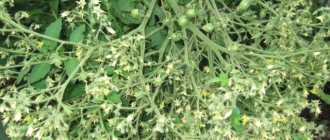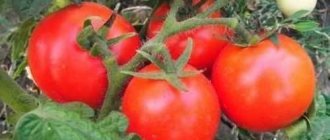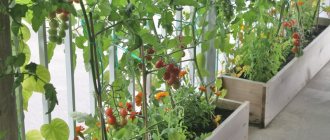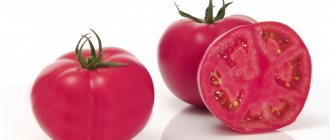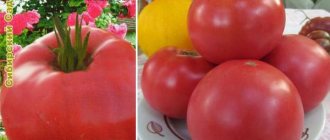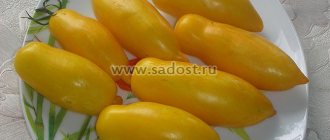Description of the variety
The Cheerful Neighbor tomato is a typical indeterminate variety. This means that it has almost unlimited growth, which is stopped at a certain stage so that it has time to form normal fruits and ripen. The variety is mid-early, about 115-120 days pass from the moment the seeds are sown to the time the harvest ripens. It is recommended to grow bushes with one, maximum two stems. The height of the bush reaches from 1.8 to 2 m, therefore it requires mandatory pinching, as well as gartering of bushes.
Characteristics
- According to the description of the originator, the variety can be safely classified as a medium-late variety; 110 - 115 days pass from the moment of full shoots to the start of fruiting. But the State Register classifies the Cheerful Neighbor as a late entry. And many vegetable growers point out that the fruits ripen really late. Most likely, the ripening time is affected by the weather. Tomato bears fruit until October;
- Tomato growers give mixed reviews about yields. Some people praise this indicator, but there are also negative assessments. What do official sources say? According to the State Register, the marketable fruit yield in film greenhouses was 8.8 - 9.5 kg per 1 square meter. The originator promises at least 1 bucket per plant, although the volume of the container is not specified. Other sources provide data on 15 - 20 kg per 1 sq. meters or about 5.5 - 6 kg per plant;
- There is no information about the immunity of the variety either from the originators or from the State Register. Gardeners are also laconic; there are no reviews about the problems associated with crop diseases. Therefore, it can be assumed that the plant is still resistant to major diseases;
- There is evidence that the tomato can tolerate short-term drought, and even during the hot period continues to form ovaries. But in cold and rainy weather this process stops;
- Our hero cannot boast of a high level of transportability. A long trip will negatively affect the appearance of the crop. There is no information about keeping quality;
- method of use is universal. First of all, tomatoes are used in their natural form, used in salads, and as a decoration for ready-made dishes—the fruit cut into rings looks like a flower. The harvest is also used for preparing preparations - the juice is of excellent quality, the paste and sauces are quite thick. However, during cooking, difficulties arise in removing dust, which accumulates in the folds between the ribs of the Cheerful Neighbor fruits.
Fruit characteristics
Tomato fruits have an original, recognizable shape - rounded and flattened, with a grooved surface reminiscent of a peeled tangerine. The color of the fruit is bright red. Cheerful Neighbor tomatoes reach up to 15 cm in diameter, weigh up to 350 g, and many chambers are formed in the middle of the fruit for the formation of seeds. The pulp of the fruit is very soft, fleshy, juicy, with a rich tomato taste. The fruits are tied in clusters of 4-8 tomatoes in one cluster.
The yield from 1 plant is from 5 to 6 kg, and from 1 sq. m comes out to 15 to 20 kg. The fruits are well transported and suitable for storage for some time. If you pick slightly unripe fruits, the shelf life can be extended due to the time when they turn red during storage and transportation. In culinary terms, they are especially well suited for preparing various salads, juices, and canning.
The variety is also universal in terms of geographic zoning, as it grows well in both southern and middle latitudes, and in the northern zone it is better to grow them in greenhouses.
Description
The plant belongs to the indeterminate species, with a height of about 1.8 meters or a little more. Shoot formation and foliage of tomato are moderate. The leaves are long, dark green, of the usual type. The inflorescence is simple. The fruit clusters are heavy and can form from 4 to 8 ovaries. About 5 clusters are formed on the central stem. Pedicel with articulation.
The fruits of the Cheerful Neighbor have a rather attractive appearance - a flattened shape, a surface with pronounced ribbing, a glossy skin, and medium density. The hearts of vegetable growers are captivated by the size of the tomato. The diameter of the fruit at the widest part can be almost 15 cm. The originator declares the weight to be 250 - 350 grams, and the State Register records 300 - 400 grams. An unripe tomato is light green, with a darker spot at the stalk; a ripened one becomes deep red. The pulp of the variety is fleshy, tender, juicy, pleasant consistency, aromatic and multi-chambered - there are more than 6 seed nests (but the chambers are small). The taste is good. The taste is rich, tomato, sweet and sour, with a predominance of sweetness. In rare cases, reviews simply call the taste sour.
Advantages of the variety
The strengths of the Cheerful Neighbor tomatoes include the following characteristics:
- large fruits of high quality presentation;
- high productivity;
- versatility: grown in open ground and in greenhouse conditions;
- transportable;
- relatively long shelf life.
Disadvantages of the variety
As reviews show, the Cheerful Neighbor tomatoes have no critical shortcomings. At the same time, some features make the process of growing them more labor-intensive, namely:
- need for garter;
- mandatory stepsoning.
Agricultural technology for tomato cultivation
The mid-season tomato Cheerful Neighbor is designed for growing in protected soil conditions. The tomato is characterized by an average ripening period, excellent taste, and universal use in cooking.
READ MORE: Silver hoof apple tree description photo reviews planting
The description of the variety indicates that when growing tomatoes it is better to use the seedling method. Sowing seeds for seedlings is carried out in March. Before planting, the seed is treated with an aqueous solution of potassium permanganate and a growth stimulator.
Prepared soil is poured into containers, lightly compacted, furrows 1 cm deep are made and watered with warm water. After planting the seeds, the container is covered with film or glass to create a greenhouse effect, which ensures the friendly emergence of seedlings.
The peculiarities of growing the variety consist in carrying out agrotechnical measures related to stimulating crop growth and strengthening the root system. At the stage of formation of 2-3 true leaves, picking is carried out in separate containers.
When planting in a permanent place, the bushes are placed at a distance of 40 cm from each other, 60 cm are left between the rows. It is recommended to place 3 bushes per 1 m². The description of the process of growing a crop includes a system of agrotechnical measures to care for the plant.
An important stage of cultivation is to ensure timely watering, which is recommended to be done at the root. To do this, use warm water. In order to distribute moisture evenly and prevent intense evaporation, the soil is mulched.
Black fiber and organic materials (hay, straw, leaves) are used as mulch. This action helps prevent the growth of weeds. You can install a drip irrigation system in the greenhouse, which will significantly save time and increase crop productivity.
At each stage of plant development, it is necessary to regulate the quantitative composition of fertilizers. For preventive purposes, bushes are treated against diseases and biological pests. The plant requires periodic loosening of the soil and hilling.
Reviews from those who grew the Cheerful Neighbor variety testify to the unusual shape of the bright red fruits and exceptional taste.
Margarita Antonova, 56 years old, Kolomna.
Last season, on the recommendation of neighbors, I purchased a bag of seeds of the Cheerful Neighbor variety. I grew it through seedlings in the usual way for tomatoes. After forming 1 flower cluster, I planted the bushes in a greenhouse.
Tall bushes had to be tied to a support. I was pleased with the clusters of ripening tomatoes and their relief shape. Funny tomatoes, even if you send them to an exhibition, they have an amazing taste and bright color.
The description of the variety and the declared characteristics fully correspond to the cultivated crop.
Mikhail Vorobyov, 59 years old, Pyatigorsk.
Features of growing tomatoes
Tall tomatoes are grown using the same technology as low-growing ones, but with some distinctive features. All measures in the agricultural technology of the Cheerful Neighbor tomatoes can be divided into the following stages:
- Preparing the area for future beds.
- Preparation of soil mixture for seedlings.
- Preparing tomato seeds for sowing.
- Sowing and caring for seedlings.
- Planting in beds and caring for bushes.
Tomato Cheerful neighbor
Description of the tomato variety Cheerful Neighbor, reviews, photos
Mid-season, tall, high-yielding, large-fruited variety of tomatoes for greenhouses. The period from full germination to the beginning of ripening is 110-115 days.
Bush of indeterminate type, powerful, up to 1.8 meters high. Requires tying to the trellis and pinching. The manufacturer recommends forming the plant into 1-2 stems. There are 4-8 ovaries in the brushes.
Fruit characteristics
The fruits are flat-round, grooved, rich red in color at maturity, weighing 250-350 grams, fleshy, very tasty. The pulp has a rich tomato taste and aroma, so the best use of the variety is slicing, salads, canning in its own juice, making juices and pastes.
Features of cultivation, planting and care
Sowing the seeds of this variety of tomatoes for seedlings is carried out 60-65 days before the intended planting in the ground. Seedlings dive at the stage of two true leaves. When planting seedlings in a permanent place per 1 sq. It is recommended to place up to 3 plants per meter of land; when forming into 1 stem - up to 4.
Further care for tomatoes consists of timely watering, fertilizing with complex mineral fertilizer, pinching and preventive measures to protect against diseases and pests.
When growing tomatoes in a greenhouse, we recommend installing a drip irrigation system - this saves your time and effort, and also increases plant productivity and reduces the risk of late blight.
If you grew Cheerful Neighbor tomatoes, please write whether you liked them or not. What was the yield and taste of the fruits like under your climatic conditions? How do you rate the disease resistance of this variety? If possible, attach a photo of your tomatoes to your comment. Thank you!
Your reviews of the Cheerful Neighbor tomato and additions to the description will help many gardeners evaluate this variety more objectively and decide whether it is worth planting or not.
Site preparation
First of all, taking into account the predecessors that grew on the ground last season, they choose where to plant tomatoes. According to the principles of crop rotation, excellent predecessors for tomatoes will be cabbage, cucumbers, legumes, root vegetables, grains, and green manure herbs. On the contrary, tomatoes should not be planted after potatoes, peppers, and eggplants. It should also be taken into account that you cannot plant different varieties of tomatoes next to each other, because they will pollinate each other and the distinctive characteristics of both varieties will be lost, not to mention the impossibility of using the seeds collected from them next year.
In October-November, organic matter (manure, compost) is added to the soil, after which deep plowing is carried out. Instead, in August you can sow green manure grasses or root crops, which will gain weight in October-November and are plowed without mowing or collecting. The green mass of herbs and the pulp of root crops will become a natural fertilizer, which will rot over the winter and be processed by worms and bacteria.
An alternative to organics can be mineral fertilizers, which are distributed in dry form over the surface, namely: superphosphates (40-50 g per 1 sq. m), potassium nitrate (10-15 g per 1 sq. m) and ammonium nitrate (10- 25 g per 1 sq. m). After applying mineral fertilizers, plowing is also carried out.
Important! Plowing the plot for the winter helps to freeze out the larvae of pests and pathogens of tomatoes.
Which early tomato varieties to choose?
The category of early tomatoes has a number of advantages:
- disease resistance;
- maximum adaptability to climate change;
- excellent taste;
- stable and increased fertility;
- rapid maturation;
- ease of care.
Depending on where they grow, quickly ripening tomatoes are divided into groups:
- For unprotected soil;
- For a greenhouse environment;
- For apartment conditions.
"Aphrodite F1". Compact hybrid (determinate), bearing fruit 70-80 days after sowing. Its length is 50-70 cm, weight - 100-150 g. The round, bright fruits are very elastic in structure, making them excellent for transportation. They are universal in their direction.
"Valentina." This tomato, a super early variety, is particularly hardy and withstands drought. It is characterized by a high content of ascorbic acid. Reaches 70 cm in height. Ripening occurs 95-100 days after planting. Does not require the formation of bushes. A ripe tomato has a rich red color and a plum-like shape. Its skin is dense and rough, which makes it resistant to cracking.
"Benito F1". A low plant (40-50 cm) with a growing season of 70 days. A ripe vegetable is fleshy in structure and oblong in shape. The weight is quite large (up to 150 g). Benito F1 is not prone to verticillium wilt, is resistant to fusarium and is universal in use.
"Don Juan". The variety ripens 90-100 days after sowing. Its distinctive feature is its unusual elongated shape with a pointed “nose”. Early ripening fruits are crimson in color with longitudinal pale yellow stripes. They can be stored for a long time and are suitable for canning.
"Doll F1". A subspecies with a pink color, which is popular due to its high yield. Its length is at least 85-90 cm. Requires moderate frequency of pinching. The average weight ranges from 150 g to 200 g, but with careful care it can reach 450 g. It is used for processing and fresh consumption.
Note! In order for ultra-early varieties to have high productivity, proper soil preparation is necessary. Feed it with rotted manure (8-10 kg/m²). The soil should be fertilized with a mineral-organic complex (15 g of urea, 25 g of potassium magnesium and 50 g of superphosphate per 1 m²).
The earliest varieties of tomatoes are represented by the following types: “Golden Brush”, “Yarilo”, “Mandarinka”, “Poznan”, “Greenhouse early ripening F1”, “Sugar plum raspberry”, “Sweet bunch”, “Blagovest”, “Superstar”, “Meal”, “Present F1”, “Friend”, “Cavalier”, “Funtik”.
"Golden brush" An indeterminate hybrid, 1.5 m long. It bears fruit 96-98 days from the moment of planting in protected ground. Tomatoes in this group are small in size (25-30 g), but have a pleasant taste. Outwardly, they slightly resemble a yellow-golden pear. They need to be pinched and tied up.
"Tangerine" Tall indeterminate plant with a growing season of 90-100 days. In clusters of this type, up to 10 deep orange tomatoes weighing 75-110 g grow. Their value is not only in their wonderful taste, but also in their invulnerability to difficult weather conditions.
"Sugar plum raspberry." Semi-determinate bush that gives a harvest on 85-97 days. Most often it stretches to a height of 105-140 cm. The ripe vegetable stands out among others with its crimson hue and plum-like shape. The advantage of these tomatoes is the significant amount of vitamins they contain and their delicate taste. They are stored for a long time and can be easily transported. Gartering and pinching are an indispensable rule for a generous harvest.
"Sweet bunch" The tallest type (from 3 m), which must be tied up and formed into 2 stems. Gives multiple rich harvests. Clusters of round and sweet fruits, 20-50 pieces each, look like bunches of grapes.
"Meal" A tasty hybrid with oval fruits (15-20 g) of bright red color. The fixed stem length is 160-175 cm. Good for long-term preservation and canning, as well as for fresh consumption. Particularly popular for its vitality and endurance.
"Superstar". Semi-determinate, excellent for sheltered areas or protected soil. A large (190-260 g), flat-round and sweetish vegetable, used in salads. The addition of a meter-long trunk is always welcome.
The following subspecies are common: “Indoor Surprise”, “Minibel”, “Florida”, “Indoor Pygmy”, “Balcony Miracle”, “Siberian Precocious”, “Pinocchio”, “Garden Pearl”, “Bullfinch”, “Tiny Tim”, "Angelica", "Ballerina".
"Room Surprise" Among tomato crops intended for cultivation at home (on balconies or loggias), this variety produces a bountiful harvest first (on the 80th day). This is a compact vegetable (up to 45 cm) that does not require the formation of shoots. Its weight ranges around 60 g. The red plum-shaped fruit can be either canned or cut into a salad.
"Minibel". Ultra-early ripening varieties for cultivation under film cover, determinate. The plant is miniature (the stem is no longer than 35-40 cm), but it bears fruit well even in the absence of proper care and insufficient lighting. Tomatoes of this type are small - 15-20 g. They taste moderately sweet with a slight sour note.
"Indoor pygmy." A potted crop for universal use, which has proven itself well in cultivation on terraces, balconies, loggias, as well as in dense plantings of vegetables and flowers. Low-growing standard trunks (25-35 cm) of tomato can be done without pinching. The pygmy bears a bountiful harvest of ripe, sweet red tomatoes that are round in shape.
"Pinocchio". After sowing, the standard low plant matures in 90-95 days. Miniature fruits weighing no more than 15-20 g, round in appearance and sweet and sour in taste. The stepson procedure is not required. Pinocchio tomatoes are in demand among vegetable growers due to their decorative properties and high fertility.
"Garden Pearl". Another variety that is recommended for home use (on a windowsill or balcony). This is one of the richest varieties of crops in terms of yield, which produces about 350-400 pink fruits in one season. Super early tomatoes appear already on the 82nd day. The stem is creeping, no more than 40 cm in length. There is no need for pinching. In addition to nutritional value, tomato has good decorative qualities, so it looks great in a flower garden.
Choosing an early ripening variety of tomatoes will not be difficult if you decide in advance in what conditions you plan to cultivate.
Preparing soil for seedlings
For these purposes, you can buy a ready-made mixture, but this will increase the overall costs of growing tomatoes. You can use regular soil, but it will not give the same results as nutrient mixtures. Therefore, you need to prepare the soil for seedlings yourself, mixing the following components in equal proportions: regular soil, turf soil or sawdust, peat, river silt, then add 2 cups of ash to 10 liters of this mixture.
In some sources you can find information about the need to add humus, but others say that it unnecessarily heats the mixture, which inhibits the germination of seeds until they die. The last observation is more correct, but this can be verified experimentally by allocating a couple of cups of seeds to the mixture containing humus.
When the mixture is ready, it should be calcined in the oven to disinfect it from pathogens and pests. An alternative is treatment with a 1-2% solution of potassium permanganate, which is used to soak the mixture.
Seed preparation
First of all, the seeds should be checked for germination by spreading them on a damp cloth. After 3-5 days, the seeds burst: if most of the grains have sprouted, then the seeds are suitable, if not, you need to select another seed or buy a new one.
After this, the seeds must be treated against diseases. To do this, prepare a solution of fungicides such as Agat and Maxim according to the instructions for these drugs. In addition to disinfection, Agate strengthens the immune system of future plants and stimulates their germination.
At the final stage, the seeds are treated with growth stimulants, namely Kornevin, Zircon, Silk, Epin-extra. Solutions are prepared according to the instructions. Growth stimulants can be replaced by soaking in an ash solution. To do this, dissolve 1 tbsp in 1 liter of water. spoon of wood ash. The seeds are soaked in the solution, filtered and dried without prior washing.
Sowing seeds and caring for seedlings
Seeds for seedlings are sown 60-65 days before the date of planting the seedlings in the ground. Depending on the region, these dates come at the end of February or the first half of March. Accordingly, when growing Cheerful Neighbor tomatoes in greenhouses, this period may be shifted to an earlier period.
The prepared soil is distributed into pots or boxes where the seeds will be sown. The soil is pre-watered with water heated to 40-50 ºС. The depth of sowing seeds is up to 1-2 cm. After sowing, the pots and boxes are covered with film or sheets of glass, which cover them until the first shoots appear.
Important! Boxes and pots for seedlings should have holes in the bottom for moisture drainage.
Tomato sprouts peak at the age of 1-2 true leaves, for which they are planted in different and deeper boxes. At the same time, they are filled with soil to about 2/3 of the volume. The seedlings are buried in the ground, and then, as the stem grows, they are laid on the surface in a spiral, sprinkled with earth. This procedure is repeated until the seedling container is filled to the top. This allows the Cheerful Neighbor tomato to form a proper and powerful root system. Periodically, the soil under the seedlings needs to be moistened. At the age of 60-65 days, the seedlings are ready for planting.
Tomato variety Cheerful neighbor
Strongly ribbed large-fruited tomatoes are not often found in gardens. But they have quite attractive characteristics, so every tomato grower should try to grow such an interesting vegetable. Of course, such varieties have their own characteristics, strengths and weaknesses, and before growing you need to study information about the variety. Recently, vegetable growers were offered another new product in this category to try under the very optimistic name Cheerful Neighbor. In 2015, the variety was registered in the State Register of Breeding Achievements of Russia. The applicant and originator is Gavrish Breeding Company LLC. Our hero is allowed to be cultivated in all regions of the country. Recommended for cultivation in film greenhouses of private farms. But it is also suitable for glass greenhouses; in addition, in the southern regions the plant is cultivated in open ground. The variety is not a hybrid.
Description
The plant belongs to the indeterminate species, with a height of about 1.8 meters or a little more. Shoot formation and foliage of tomato are moderate. The leaves are long, dark green, of the usual type. The inflorescence is simple. The fruit clusters are heavy and can form from 4 to 8 ovaries. About 5 clusters are formed on the central stem. Pedicel with articulation.
The fruits of the Cheerful Neighbor have a rather attractive appearance - a flattened shape, a surface with pronounced ribbing, a glossy skin, and medium density. The hearts of vegetable growers are captivated by the size of the tomato. The diameter of the fruit at the widest part can be almost 15 cm. The originator declares the weight to be 250 - 350 grams, and the State Register records 300 - 400 grams. An unripe tomato is light green, with a darker spot at the stalk; a ripened one becomes deep red. The pulp of the variety is fleshy, tender, juicy, pleasant consistency, aromatic and multi-chambered - there are more than 6 seed nests (but the chambers are small). The taste is good. The taste is rich, tomato, sweet and sour, with a predominance of sweetness. In rare cases, reviews simply call the taste sour.
Characteristics
- According to the description of the originator, the variety can be safely classified as a medium-late variety; 110 - 115 days pass from the moment of full shoots to the start of fruiting. But the State Register classifies the Cheerful Neighbor as a late entry. And many vegetable growers point out that the fruits ripen really late. Most likely, the ripening time is affected by the weather. Tomato bears fruit until October;
- Tomato growers give mixed reviews about yields. Some people praise this indicator, but there are also negative assessments. What do official sources say? According to the State Register, the marketable fruit yield in film greenhouses was 8.8 - 9.5 kg per 1 square meter. The originator promises at least 1 bucket per plant, although the volume of the container is not specified. Other sources provide data on 15 - 20 kg per 1 sq. meters or about 5.5 - 6 kg per plant;
- There is no information about the immunity of the variety either from the originators or from the State Register. Gardeners are also laconic; there are no reviews about the problems associated with crop diseases. Therefore, it can be assumed that the plant is still resistant to major diseases;
- There is evidence that the tomato can tolerate short-term drought, and even during the hot period continues to form ovaries. But in cold and rainy weather this process stops;
- Our hero cannot boast of a high level of transportability. A long trip will negatively affect the appearance of the crop. There is no information about keeping quality;
- method of use is universal. First of all, tomatoes are used in their natural form, used in salads, and as a decoration for ready-made dishes—the fruit cut into rings looks like a flower. The harvest is also used for preparing preparations - the juice is of excellent quality, the paste and sauces are quite thick. However, during cooking, difficulties arise in removing dust, which accumulates in the folds between the ribs of the Cheerful Neighbor fruits.
Agricultural technology
It is advisable to grow the variety as seedlings. It is best to calculate the time for sowing seeds yourself to take into account the climatic characteristics of the region and the method of cultivation. If you listen to the originator, he suggests sowing seeds from February to March, and replanting in April - May. Picking is carried out at the stage of 2 true leaves. Plants aged 60-65 days are suitable for replanting. The recommended planting density will depend on the method of forming the bush. If a tomato is formed into 1 stem, then up to 4 plants can be planted per 1 square meter; if there are 2 stems, then 3 bushes. After transplantation, the crop is tied to a support, and pinching is carried out as necessary. Some gardeners write that our hero can withstand a load of 3-4 stems, although in this case the fruits are smaller and the harvest ripens later. Agricultural technology corresponds to the culture as a whole. The plant must be watered on time, fertilizing is carried out mainly with mineral fertilizers, prevention from diseases and pests is mandatory.
Cheerful Neighbor is an interesting new tomato to add to your collection. Yes, there are conflicting reviews about it, the yield can be disappointing, and the shape of the fruit is sometimes far from what is stated - an ordinary flat-round tomato. The issue here is most likely a matter of mis-sorting. But if you become the owner of a real variety, and even grow it according to the rules, then you definitely will not be disappointed in it. The disadvantages are relative; any tall plant will have to be tied up and shaped. But belonging to varietal crops provides great benefits. You can collect seeds yourself, controlling their quality.
Planting in the ground and caring for bushes
In the second half of May or early June, seedlings are planted in an area that has been previously loosened and weeded. The planting rate for the Cheerful Neighbor tomatoes is 3-4 bushes per 1 square meter. m. The hole for seedlings should be fertilized with a glass of humus and watered with warm water. The seedlings are buried in the hole to the level of the beginning of the stem and covered with earth. The area around the bush is mulched with sawdust. At the same time, a wooden stake about 2 m high is driven in next to the bush to secure future bushes.
Cheerful Neighbor tomato bushes are grown in 1-2 stems, removing excess shoots when they reach 5-6 cm. It is recommended to cut longer shoots with pruning shears, leaving small stumps - pinching the shoots prevents damage to the stems.
Tomatoes should be watered at the root once a week, avoiding allowing the soil to dry out. You cannot water the stems and fruits, otherwise the tomato will get sick. It is equally important to loosen and weed the soil under the bushes. Bushes are fertilized about two times: the first time before flowering and the second time during fruiting. To do this, solutions of superphosphates and potassium nitrate are added to the root at the rate of 30-40 g per 10 liters of water, which are consumed per 1 square meter. m.
Description and characteristics of the tomato variety Cheerful Neighbor
Every summer resident has a favorite variety of vegetable in his repository of knowledge, the Cheerful Neighbor tomato. Summer residents, living outside the city and constantly planting vegetable gardens, have studied many varieties of tomatoes.
What varieties of non-ordinary tomatoes exist?
The market is teeming with an abundance of different varieties and hybrids of tomatoes, they differ in color, size, shape. Here are the characteristics of some varieties of tomatoes with unusual color and shape. These are the varieties that have already been planted in the garden. The red zebra attracted with its unusual red-orange striped color, Gold Krone with orange small cherry tomatoes, Grape Sausage with a very unusual shape and color, an oblong orange-green beauty, Bleve P-20, a red-black tomato.
Korneevsky is a variety of pink tomatoes that are grown in Russia, Mazarin, similar in shape to strawberries. All this is a description of the original varieties, which are less susceptible to disease than ordinary tomatoes. Productivity is high. They are planted in open ground so that neighbors can see and be surprised by our beauties. They all look great in a salad bowl with a couple of cucumbers and green stuff. Suitable for seaming, the red and black tomato perfectly complements the composition with orange bananas.
Description of the variety
What summer resident has not planted tomatoes in his garden? And most often, new varieties are chosen for this purpose in addition to the usual ones. Today our hero of the garden and table, tomatoes is the Cheerful Neighbor. The name was given to it because of the shape of the fruit, similar to a pumpkin, with ribbed sides. Juicy, with excellent taste, these tomatoes will decorate the dinner table and a jar in the cellar.
Tall tomatoes, suitable for growing in greenhouses and open ground. High yield, a bucket of tomatoes grows from one bush. The growing season is 110-115 days. Seedlings are prepared from March to April, picked when there are 3 leaves. Planting in a greenhouse in April - May, and in an open garden bed in June, when planting in the ground, the plant must be pinched, and when it grows, tied up.
Consumers choose this variety after reading positive reviews about the tomato.
The variety is easy to care for; for a high yield, it is enough to fertilize the soil twice a season and water it in a timely manner. Every gardener grew vegetables from time to time, reading reviews from other gardeners, thanks to them, other gardeners learn about new products on the market.
How to plant and grow a good crop of tomatoes in open ground
Consider the list of measures for reaping a good harvest:
- Soil preparation.
- Planting a crop.
- Bush garter.
- Stepsonning.
- Feeding.
- Pest control.
The soil for planting seedlings should have an acidity level of 6 to 7 pH, if lower, feed with lime, if higher, you need to add sulfur. Plants are planted in a hole at a distance of 25-30 centimeters, humus is added to the hole, but this is not necessary, and watered. Bush gartering is carried out 3-4 times per season by lifting heavy bushes above the ground. This is done so that the bush does not lie on the ground, and also does not break under the weight of the tomato. Be sure to ensure that the bush and fruits do not lie on the ground, this can lead to infection of the bush with powdery mildew, then the entire harvest will be lost!
The bush is pruned to give it shape and a larger harvest. Shoots from the bottom of the bush that have not formed an ovary are cut off; the procedure is carried out in the morning in sunny weather. It's better to pinch off the stepsons. The leaves below are also gradually torn off, exposing the trunk under the main bush.
This is done so that nutrients do not go into the green mass, but are spent exclusively on fruits. 2 weeks after planting, feed the plant, dilute cow or chicken manure with 1/10 water and water it. Then water it with minerals every 10 days.
The best cure for fog is to spray tomatoes with a serum solution in the proportion of 1 liter of serum per 10 liters of water, carry out the procedure once a week. If you follow these tips, the tomato harvest, regardless of the variety you want to plant, will be high and there will always be a jar of beautiful, tasty and aromatic vegetables in your cellar.
Resistance to diseases and pests
Tomatoes Cheerful Neighbor show resistance to the main tomato diseases (late blight, fusarium, gray and storm rot, leaf wilt). As a preventative measure, fungicides are treated with Ridomil, Quadris, Agat, Maxim, and Bordeaux mixture. It is advisable to carry out two treatments after planting seedlings with an interval of 10-15 days.
The main pests of tomatoes, like other nightshades, are the Colorado potato beetle, aphids, whiteflies and others. Therefore, simultaneously with fungicide treatment, preventive treatment against pests is carried out, preparing solutions of insecticides Confidor, Antrakol and others.
As a conclusion, it is worth noting that due to the high yield and excellent characteristics of the fruits of the Cheerful Neighbor tomatoes, they are rightfully one of the best varieties for industrial production. However, they also perform well in summer cottages.
Care
Treatments include:
- Weekly watering at the root. It is not recommended to moisten the stems to avoid the occurrence of diseases.
- Regular weeding of the ground under the bushes.
- Fertilizing is allowed only at the root of the bushes.
- In case of pests, it is allowed to water with toxic substances over the entire area of the plant until the flowering period.
Thanks to their high yield, “Vesely Neighbor” tomatoes are rightfully one of the most popular varieties for industrial production. However, they also took root in private garden plots and won people’s love! They are most often used for making juices and sauces, or for consumption in their natural form.

